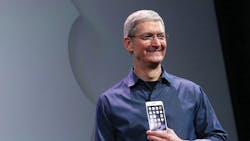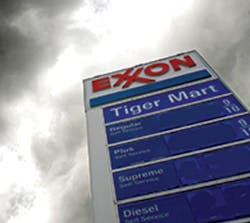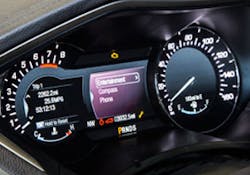What drove change in the IW US 500, the biggest publicly-owned manufacturing companies headquartered in the United States? In 2015, the answer could have been technology or China or the strong dollar, but we’re placing our money on a single commodity – oil.
In January 2015, oil prices stood at approximately $107 a barrel. In February 2016, they fell to a low of just over $32. Currently, they are hovering around $48 to $50 a barrel. That recovery has brought some relief to the industry, but exploration, production and other expenditures have been cut back severely. Analysts at Wood Mackenzie estimate global exploration will be cut over $1 trillion from 2015 to 2020. In the U.S. alone, capex spending by the industry has been cut by more than half, or $125 billion, from 2016-2017 and another $200 billion in cuts are expected out to 2020, the firm projects.
With oil companies sharply pulling back on spending, their employees and their supply chain felt the impact. In Texas, hard hit by low oil prices, 113,000 employees in energy extraction and manufacturing lost their jobs in 2015.
Here are some of the highs and lows in the US 500 as names familiar on Main Street and those known mainly to their investors rode the waves of change in 2015.
Revenue
As it perennially does, ExxonMobil (IW500/1) topped the IW 500 with revenue of $268.86 billion. While that is an astonishing number, keep in mind that Exxon saw its revenue fall by 35% from the previous year. Even with that fall, the difference in revenue between Exxon and number two Apple was a little more than the annual budget of the state of Arizona. Exxon also saw its net income chopped in half, from $33.6 billion to $16.1 billion.
“While our financial results reflect the challenging environment, we remain focused on the business fundamentals, including project execution and effective cost management,” said Rex W. Tillerson, chairman and CEO. “The scale and diversity of our cash flows, along with our financial strength, provide us with the confidence to invest through the cycle to create long-term shareholder value.”
While Exxon remains a rich company with well-regarded operations in exploration, refining and chemicals, the oil giant took a number of heavy blows recently, including the decision April 26 by Standard & Poor’s to lower its credit rating from AAA to AA+. S&P said it was taking the action in part because Exxon was facing higher costs in the future to replace its petroleum reserves. In 2015, Exxon replaced just 67% of the oil it produced, reversing the situation of the past 21 years when new oil exceeded what was pumped out of the ground. S&P also cautioned that Exxon might take money from improved earnings in the future to plow into shareholder returns rather than “building cash or reducing debt…”
At the other end of the revenue column, TETRA Technologies (IW500/500) cracked our list at number 500 with sales of $1.13 billion. Tetra, an oil and gas products and services company based in The Woodlands, Texas, had a revenue increase of nearly 5% in 2015, but its fourth quarter results showed all the signs of the oil industry’s woes. Sales fell 22% and the company took a series of defensive measures, including layoffs, salary reductions and a sharp drop in capex expenditures planned for 2016.
In the first quarter of 2016, Tetra continued to feel the effects of the oil price woes. Revenue fell to $169.3 million, a decline of 34.3% from the fourth quarter of 2015. Tetra said the decline was largely due to a 36% reduction in the North American rig count.
Net Income
Construction is well along for Apple’s (IW500/2) new headquarters in Cupertino, Calif., estimated to cost $5 billion when it is completed in 2017. Given that Apple led the IW 500 in net income with $53.39 billion, is that wildly extravagant or chump change? We’ll let you be the judge, but consider this – it took Apple just over a week of sales to cover the cost of the building.
Apple’s net income increased 35% from its fiscal 2014. And it was nearly three times as much as second place Gilead Sciences (IW500/34) ($18.1 billion). Rounding out the top five were ExxonMobil, Johnson & Johnson (IW500/16) and IBM (IW500/12).
“Fiscal 2015 was Apple’s most successful year ever, with revenue growing 28% to nearly $234 billion. This continued success is the result of our commitment to making the best, most innovative products on earth, and it’s a testament to the tremendous execution by our teams,” said Tim Cook, Apple’s CEO.
After this spectacular year, perhaps there was nowhere to go but down. For the first half of its fiscal 2016 (ending March 26), Apple has been unable to match its 2015 results, with sales for the six months down 4.7% and net income down 8.6%. Apple saw unit sales of its iPhone, iPad and Mac products all drop by double digits in a year-to-year comparison. Bright notes for the company were increased sales of its services and other products such as the Apple Watch and Beats headphones.
Officials at Apache Corp. (IW500/154) surely wish they could have the “troubles” that Apple does. The Houston, Texas based oil and gas exploration and production company posted the highest net loss in the IW 500 of $23.1 billion. The company said it would slice capital spending this year by $1.4 to $1.8 billion, depending on commodity prices and resulting cash flow. This is a reduction, the company noted, of more than 60% from 2015 and more than 80% from 2014.
“In 2016, we plan to be cash flow neutral after dividends and believe this can be achieved at $35 oil with minimal non-core, non-producing asset sales,” said John J. Christmann IV, Apache’s CEO and president. “Our target is for net debt at the end of 2016 to be unchanged or lower than it was at the end of 2015.”
Market Cap
Not surprisingly, Apple also led the IW 500 in market capitalization, ending the year worth $639.93 billion. Coming in a distant second was Microsoft (IW500/10) at a valuation of $354.39 billion. Rounding out the top five were Exxon Mobil, General Electric (IW500/6) and Johnson & Johnson.
Apple had no challengers on the IW 500 list, but it was engaged in a headline-grabbing duel with Alphabet, the parent company of Google, this year for the title of most valuable public company. On February 2, Alphabet passed Apple as the online search giant’s market cap hit $547.1 billion. Apple regained its lead the next day and held it until May 12, when Alphabet again took the lead.
At this writing, Apple is once again the market cap leader with a valuation of $534.3 billion. Alphabet is at $497.2 billion while Microsoft stands at $396.1 billion.
Profit Margin
The decision of Visteon (IW500/274) leaders to focus on the electronics in vehicle cockpits paid off for the Van Buren Township, Mich.-based firm as it came in first in profit margin for the IW 500 with 70.39%. Sales for the company grew 25% to $3.2 billion. The company acquired the automotive electronics business of Johnson Controls in July 2014 and has since pared non-electronics automotive interiors and climate control businesses.
Visteon’s profit margin reflected its sale of 70% ownership interest in Halla Visteon Climate Control Corp. for $3.6 billion to an affiliate of Hahn & Co., and Hankook Tire Co. Ltd. Visteon made its shareholders happy with a special $1.75 billion cash distribution and authorized an additional $500 million share repurchase.
It’s a far cry from May 2009, when the auto parts supplier, a spin-off of Ford, filed for Chapter 11 protection. Visteon has since expanded its customer base, producing components not just for Ford, but also Renault/Nissan, Mazda, BMW, GM, Honda, VW, Daimler and others. The majority of the company’s sales are now in Asia and Europe. Visteon has 50 facilities, including 22 manufacturing plants and more than 11,000 employees.
Coming in second with a profit margin of 55.48% was Gilead Sciences. Headquartered in Foster City, Calif., the biopharmaceutical company racked up sales of $32.63 billion and had net income of $13.1 billion. Gilead has 7,000 employees and its products, sold in more than 30 countries, include treatments for HIV and chronic hepatitis.
Not everyone is happy with Gilead’s profit story. A major contributor to Gilead’s profitability are two drugs for the treatment of Hepatitis C - Sovaldi and Harvoni. While very effective treatments, an investigation by the Senate Finance Committee concluded that the two drugs were excessively expensive. Committee investigators found that a single course of treatment for Solvadi cost $84,000 ($1,000 per pill) and Harvoni was introduced at a price of $94,500.
“Gilead knew these prices would put treatment out of the reach of millions and cause extraordinary problems for Medicare and Medicaid, but still the company went ahead. If Gilead’s approach to pricing is the future of how blockbuster drugs are launched, it will cost billions and billions of dollars to treat just a fraction of patients,” Sen. Ron Wyden, D-Ore., said. “America needs cures for cancer, Alzheimer’s, diabetes and HIV. If those cures are unaffordable and out of reach to millions who need them, Congress will not have met its responsibilities to the American people.”
Motor City
Finally, two stalwarts of American manufacturing – General Motors (IW500/3) and Ford (IW 500/4) - enjoyed a continuing thirst for new cars and trucks by American and global consumers. General Motors climbed from fifth to third place in the IW 500. Though its net revenue declined from $155.9 billion in 2014 to $152.4 billion in 2015, that was largely a result of the impact of the strong U.S. dollar. Holding exchange rates steady, the company’s revenue would have been $5.8 billion higher than in 2014. Moreover, the company set a record for earnings, clearing $9.7 billion.
Ford also climbed in the list, from seventh to fourth, as its revenue grew 3.8% from $144 billion in 2014 to $149.5 billion in 2015. Ford had net income of $7.4 billion. Ford’s UAW employees couldn’t have been happier. The company presented them with bonus checks for $9,300.
About the Author
Steve Minter
Steve Minter, Executive Editor
Focus: Leadership, Global Economy, Energy
Call: 216-931-9281
Follow on Twitter: @SgMinterIW
An award-winning editor, Executive Editor Steve Minter covers leadership, global economic and trade issues and energy, tackling subject matter ranging from CEO profiles and leadership theories to economic trends and energy policy. As well, he supervises content development for editorial products including the magazine, IndustryWeek.com, research and information products, and conferences.
Before joining the IW staff, Steve was publisher and editorial director of Penton Media’s EHS Today, where he was instrumental in the development of the Champions of Safety and America’s Safest Companies recognition programs.
Steve received his B.A. in English from Oberlin College. He is married and has two adult children.


